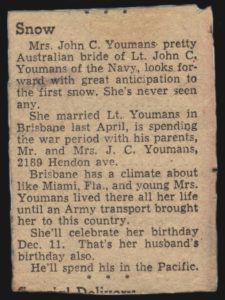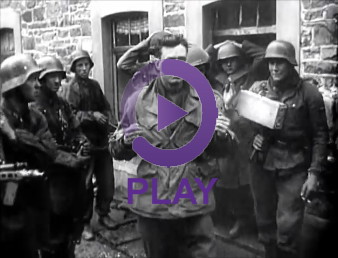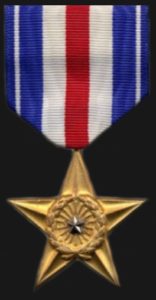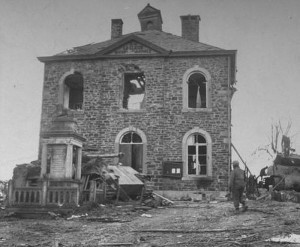Scott A. Youmans
1919-2004
Incredible stories sometimes surface at unexpected time and trigger curiosity. A recent stop by Gérard Grégoire in La Gleize unearthed an incredible story.
Gérard Grégoire is the former director of the tourism information center of La Gleize, as well as the former curator of the LaGleize 44 museum. The meeting was pertaining to detail information for a new article and focused on the King Tiger tank sitting at the center of the village.
http://www.miaproject.net/the-battlefield-then-now/kampfgruppe-peiper-2/
As the conversation went on, Gérard dug up material from his archives. He then came back with a small photo album containing two dozens of yellowed photographs. The cover read “Snapshots” and was the size of a card game, undoubtedly of American origin. It had been found in the ruins of the city hall of La Gleize just after the battle and given to Gérard in the 1950’s. The album had seen better days, was not named and eventually ended up in a drawer. That day, when Gérard handed us the album asking if it was possible to identify the owner, the terrible battle of the La Gleize caldron was about to resurface.
 Little did we know that the snapshots would become the key to the whole story.
Little did we know that the snapshots would become the key to the whole story.
“Youmans” was googled on internet. After a few pages, there was a link to a Silver Star citation. It referred to a 1st Lt Scott A. Youmans, awarded the Silver Star for gallantry in action on December 19 at Stoumont with the 3rd Battalion of the 119th Infantry (30th Infantry Division).
That was meaningful.
The icing on the cake came when the newspaper clipping was peeled off the back of the photo and revealed “Scott A Youmans – 1Lt Inf”. There were few doubts left as to who the album belonged. The young officer identified as Scott Youmans indeed appeared on several other pictures with his mom and siblings. Two days after the album resurfaced, the owner was identified!
It was not the end of the story though. The handsome officer was strangely familiar. He had a particular hairline and looked like a movie star.

Stoumont – December 19, 1944. Lt Youmans and his men are among the last GI’s captured by SS Grenadiers. The scene was recorded by an SS war correspondant.
Gérard Grégoire was astonished of the recent discoveries and another visit in LaGleize dug out more information. He recalled that back in the 1970’s, a former US Navy officer stopped at LaGleize and visited his museum. The visitor told Gérard that his brother was in the museum and pointed to a well known picture taken by an SS-Kriegsberichter (German war correspondant) during the battle of Stoumont. A picture showing an unknown American officer surrendering to Waffen SS Grenadiers. An American officer with a particular hair line and looking like a movie star.
The visitor introduced himself as John C Youmans. Gérard and John talked at length about the battle, about Scott and his whereabouts. After the war Scott had married a French lady and moved to Switzerland, where he was working as civil engineer. Gérard established contact and later visited with Scott and his wife. Little did both know that a war memorabilia was sleeping deep in a drawer of La Gleize.
After being captured, Scott stayed in Stoumont and was later transferred to La Gleize with other 119th Infantry POW’s and found shelter in the basement of the city hall. His remembrance of those terrifying days in the La Gleize caldron were recorded by an Associated Press correspondant and later published in the Eugene Register Guard, newspaper of Eugene, Oregon.
“… There were nine men in the tiny cellar, five captured American officers and four German guards. The cellar was nine feet long and four feet wide. It was the first shelter (we) could find when the American guns opened up … The German guards were frightened. They began to sing to keep up their spirit. They sang the Nazi soldier’s favorite sentimental song “Lily Marlene”. They were finishing one chorus when the first shell hit the shelter. It crashed directly through the wall with a tremendous explosion – and all the singing stopped. All four German guards were either killed or badly wounded. We tried to give them first aid as well as we could. While one of the American officers was trying to patch up one wounded man, he himself was killed when the second shell hit. We were caught in the middle of a barrage by our own guns. I never knew anything could be that bad in my life. In the next 30 seconds, three more 105mm shells struck the cellar, rocking the whole area. One of the wounded Nazi began screaming and tried to crawl across me, but he died in a couple of seconds. I could feel his blood running over me, warm in that cold room – but I was afraid to move – his body was some shelter against flying fragments. »
were nine men in the tiny cellar, five captured American officers and four German guards. The cellar was nine feet long and four feet wide. It was the first shelter (we) could find when the American guns opened up … The German guards were frightened. They began to sing to keep up their spirit. They sang the Nazi soldier’s favorite sentimental song “Lily Marlene”. They were finishing one chorus when the first shell hit the shelter. It crashed directly through the wall with a tremendous explosion – and all the singing stopped. All four German guards were either killed or badly wounded. We tried to give them first aid as well as we could. While one of the American officers was trying to patch up one wounded man, he himself was killed when the second shell hit. We were caught in the middle of a barrage by our own guns. I never knew anything could be that bad in my life. In the next 30 seconds, three more 105mm shells struck the cellar, rocking the whole area. One of the wounded Nazi began screaming and tried to crawl across me, but he died in a couple of seconds. I could feel his blood running over me, warm in that cold room – but I was afraid to move – his body was some shelter against flying fragments. »
The drumbeat of gunfire continued without letup for hours. Youmans lost track of time, living in fear that each second would be his last. And then Allied planes began to bomb the area with great crunching bursts. « …It got so bad we gave up hope… » Youmans continued « …we felt it was impossible to come out of that hell alive. It kept up for two full days. We hoped at the last for a bomb or hell to hit us and end our misery to set out of that perpetual suspense… »
At the end of the two days, the remaining Nazi troops in the village bumped or blew up their vehicles and fled across the Ambleve River. The next morning American tanks and infantry came in, freeing Youmans and 21 other Americans imprisoned in other cellars.
“… That was the best present I ever received…” added Youmans “… When I went into that cellar, I thought this village was one of the prettiest I had ever seen. When I came out, I couldn’t recognize it as the same place. It had been beaten to pieces.”
Despite his ordeal, Lt Youmans promptly returned to duty.
Scott Youmans was born on December 11, 1919 in Wausau, Wisconsin. First of four sons of Jay Youmans and Florence Anderson, Scott enlisted in the Army after 4 years of high school. He followed the OCS and was commissioned 2nd Lt. He joined the 3rd Battalion of the 119th Infantry, 30th Infantry Division and, beside a week as POW of the Kampfgruppe Peiper in LaGleize, he saw all major battles of his unit. Scott passed away on September 27, 2004 at his Switzerland residence. Further contact was tried with his sons, unfortunately it remained fruitless.
Scott A. Youmans
 Awards & citation – Silver Star.
Awards & citation – Silver Star.
Scott A. Youmans, United States Army, is reported to have been awarded the Silver Star under the below-listed General Orders for conspicuous gallantry and intrepidity in action in Belgium on December 19, 1944.
Although his anti-tank platoon was cut off from adjacent units by an enemy counterattack, he courageously remained at his post and directed the fire of his men against the enemy. Hearing a wounded man call for aid during the action, he fearlessly advanced under a hail of machine gun and small arms fire and helped the man to a safe position. He then returned to his unit and directed its fire to cover the withdrawal of adjacent units until he was surrounded by the enemy and captured.
General Orders: Headquarters, 30th Infantry Division, General Orders No. 171 (1945)
Amended GO 1945-171 to read « 3d Platoon » instead of « anti-tank platoon. GO 1945-181.


